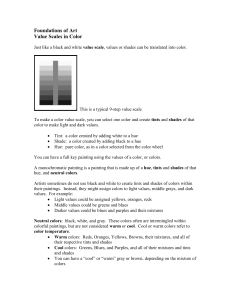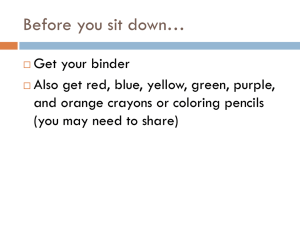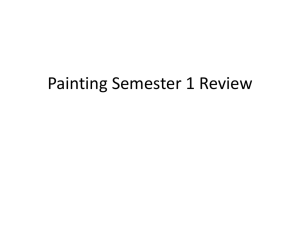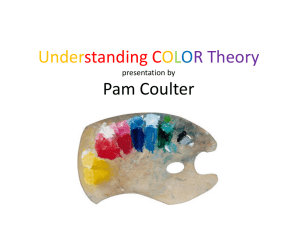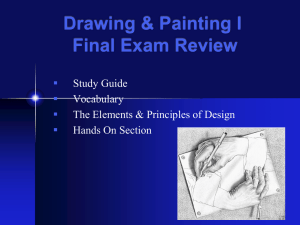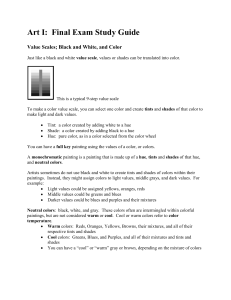Color: The element of art that is a property of light
advertisement
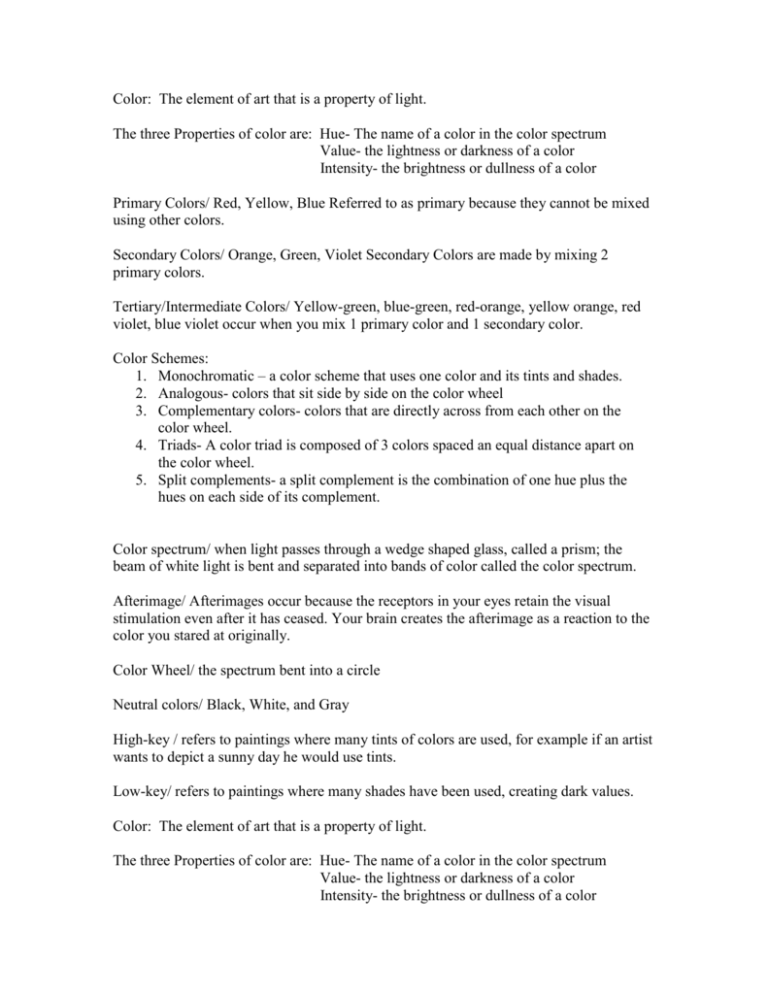
Color: The element of art that is a property of light. The three Properties of color are: Hue- The name of a color in the color spectrum Value- the lightness or darkness of a color Intensity- the brightness or dullness of a color Primary Colors/ Red, Yellow, Blue Referred to as primary because they cannot be mixed using other colors. Secondary Colors/ Orange, Green, Violet Secondary Colors are made by mixing 2 primary colors. Tertiary/Intermediate Colors/ Yellow-green, blue-green, red-orange, yellow orange, red violet, blue violet occur when you mix 1 primary color and 1 secondary color. Color Schemes: 1. Monochromatic – a color scheme that uses one color and its tints and shades. 2. Analogous- colors that sit side by side on the color wheel 3. Complementary colors- colors that are directly across from each other on the color wheel. 4. Triads- A color triad is composed of 3 colors spaced an equal distance apart on the color wheel. 5. Split complements- a split complement is the combination of one hue plus the hues on each side of its complement. Color spectrum/ when light passes through a wedge shaped glass, called a prism; the beam of white light is bent and separated into bands of color called the color spectrum. Afterimage/ Afterimages occur because the receptors in your eyes retain the visual stimulation even after it has ceased. Your brain creates the afterimage as a reaction to the color you stared at originally. Color Wheel/ the spectrum bent into a circle Neutral colors/ Black, White, and Gray High-key / refers to paintings where many tints of colors are used, for example if an artist wants to depict a sunny day he would use tints. Low-key/ refers to paintings where many shades have been used, creating dark values. Color: The element of art that is a property of light. The three Properties of color are: Hue- The name of a color in the color spectrum Value- the lightness or darkness of a color Intensity- the brightness or dullness of a color Color Schemes / a plan for organizing colors. Color Schemes: 6. Monochromatic – a color scheme that uses one color and its tints and shades. 7. Analogous- colors that sit side by side on the color wheel 8. Complementary colors- colors that are directly across from each other on the color wheel. 9. Triads- A color triad is composed of 3 colors spaced an equal distance apart on the color wheel. 10. Split complements- a split complement is the combination of one hue plus the hues on each side of its complement. Notes: Hue/ Another term for color. Intensity/ The brightness or dullness of a hue Intensity can be changed by mixing a color with its compliment creates a tone of the original hue. A color + its complement= lower intensity High intensity denotes a pure or bright hue. Low intensity denotes a dull hue. Value/ The amount of black and white in a color. The lightness or darkness of a color. Value can be changed by adding black or white to a color A color + white or black= change of value Tints/ Created by adding white to a hue, tints are also called pastels. Ex. Baby blue, peach, pink A color + white = tints/pastels Shades/ Adding black to a hue Examples: navy blue, forest green, burgundy A color + black= a shade Simultaneous contrast- 2 colors side by side interact with one another, for example a yellow green surround3ed by yellow appears greener, and Grayish-green will seem brighter when it is placed against a gray background. Pigments/ Finely ground, colored powders that form paint when mixed with a binder. Binder/ a material that holds together the grains of pigment in a form that can be spead over some surface. Ex. Linseed oil is the binder for oil paints. Solvent/ the liquid that controls the thickness or the thinness of the paint. Dyes/ Pigments that dissolve in liquid. Optical color/ when the artist reproduces colors the way he sees them. Tonality/ Sometimes an artist lets one color, dominate a work of art, if the dominate color was blue for example the painting would be said to have a blue tonality. Other colors can be present it is just that the overall effect is of one color. Arbitrary color/ When artists use color to express meaning, emotion, or to fit a personal preference, or design. Color Wheel yellow
